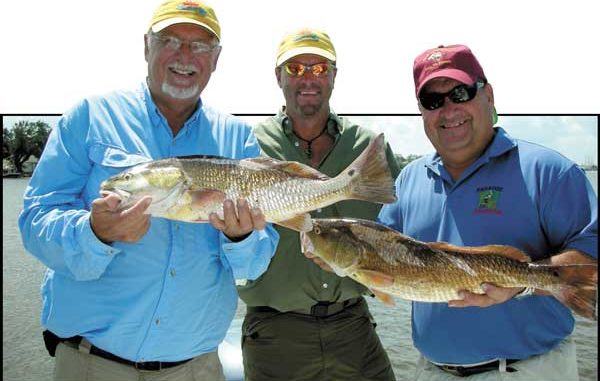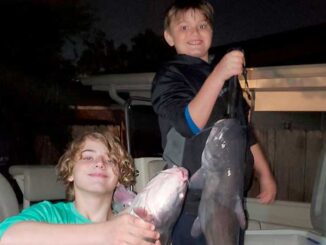
Dear Capt. Paul:
What are some good redfish spots in and around Lafitte?
Also do you know of any good trout spots in and around Lafitte?
Thanks,
Glenn Arnold
Capt. Paul’s response:
Wow! This is really a hard question to answer in the space that is allotted as there are so many locations that at different times are excellent.
Generally, the Lafitte area is referred to as the area from Lake Salvador to Barataria Bay. There are literally hundreds of fishing spots in this area that are favorered by fisherman.
They range from the southern end of The Pen at Bayou Dupont (N29 38. 396 x W090 04.285), the turns and junuctions in Bayou Dupont, the shoreline of Bayou Rigoletts and Bayou Perot and the Intracoastal Waterway from Bayou Perot to the Harvey Canal No. 2 (the Harvey Cut at N29 38.722 x W090 19.724) and the area just inside Lake Salvador called Catahoula Bay to Little Lake, Bay L’Ours and Plum Point to the west (Plum Point as N29 29.205 x W90 09.624).
The oil platform area just off of the peninsula between the upper section of Little Lake and Bay L’Ours is located at or about N29 31.436 x W90 11.855. At one time, it was on the land that continued for .75 miles to the east. Now, it is 300 yards offshore of the land to its south. The platform area is always a decent location to try.
In addition, there are some other locations that were once part of a long-gone island.
The northeast tip of the long reef is N29 33.479 x W90 10.930. The southwest tip is N29 33.189 x W90 11.308.
The center of the small circle reef is N29 32.992 x W90 11.471.
The area may have even eroded more, and parts of these reefs are no longer there, but it is worth a try.
The water in Lake Salvador averages 5 to 8 feet, while Little Lake averages 2 to 5 feet, and there are unmarked channels through Bayous Perot and Rigoletts that average 6 to 8 feet while the rest of these same lakes average 2 to 4 feet. Turtle Bay comes in at an average of about 3 to 4 feet deep, while Bayou St. Denis in spots has a depth of 18 of more feet of water. These channels and the deeper water in the summer months usually hold more fish than the shallow water, which heats up quickly.
Throughout this area you will find many white PVC poles in the waters. It is/was a means of marking commercial oyster reefs. These plastic poles are now becoming scarce as most commercial fishermen are now using GPS, but anywhere you may find some could be a decent fish-holding spot.
In addition, the Texaco canals beginning at the Baratraria Waterway at N29 34. 938 x W090 03.625 offer a weather-protected area that should be given some consideration.
And if you get all the way to Barataria Bay, try these locations:
Government Reef
Government Reef is located in the upper part of Barataria Bay between Bayou St. Denis and Wilkinson Canal. It is listed as waypoint “BAT 45A” in my Capt. Paul’s Fishing Edge of Barataria Bay program. It is at or about N29 27.320 x W89 58.271. Look for four or five pilings barely out of the water on or near the reef.
Saturday Island
Alas, there is now no longer a Saturday Island in Barataria Bay. It has been a victim of erosion. But I do have the location where Saturday Island was located. It is listed as Waypoint “BAT11” in my Capt. Paul’s Fishing Edge of Barataria Bay.
Use your depth finder to locate the hidden reef that was once Saturday Island. It is at or about N29 24.669 x W89 55.390.
St. Mary’s Point is located in the northern part of Barataria Bay between Bayou St. Denis and Bay Batiste.
I have two positions for St. Mary’s Point — he present position, and the one where it was located prior to the dramatic erosion that has taken place in the bay.
At one time, St Mary’s Point was located much farther south than the present position. The old position, a Capt. Paul’s Fishing Edge location, is now an underwater reef, and was located at or about N29 25.710 x W89 56.294. The original position was about 1,400 yards south-southwest (194 degrees magnetic) from the present position.
The present St. Mary’s Point is located at or about N29 26.385 x W89 56.067.
There are so many other lakes and bayous, it would be difficult to list them in the space and time that I have on this site.
I suggest that you get a copy of the latest NOAA chart for the Intracoastal waterway for that area. Try chart 11352-1 — New Orleans to Calcasieu River East Section. It indicates the aids to navigation (NAVAIDS) in the waterway and some of the commercial traveled lakes in the area. Use it as a start in getting the knowledge you need.
